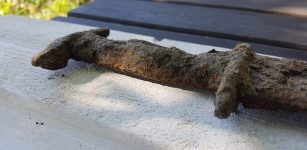2,000-Year-Old Lavatory In Turkey’s Denizli Province Will Be Restored
Conny Waters - AncientPages.com - Archaeologists continue excavations of the ruins of the ancient city of Tripolis located on the Büyük Menderes River in western Turkey's Denizli province, about 40 kilometers (25 miles) north of Denizli city center.
Earlier this year, archaeologists excavating the ancient city of Tripolis, unearthed a 2,000-year-old lavatory.

View of the ancient lavatory, in Denizli, western Turkey, Aug. 4, 2020. Image credit: AA via Daily Sabah.
It is the 40-person capacity structure with no screen or any other item separating marble toilets from each other.
Though it differs from modern lavatories due to its lack of privacy, the square-shaped structure sheds light on the hygiene standards and habits of ancient people," reports Daily Sabah
Now, the researchers are working to reopen the lavatory to the public as a tourist attraction during the next year's summer months."This is a site built to prevent pandemics," said associate professor Bahadır Duman, who heads the team of archaeologists, adding that ancient lavatories served as places for socialization. "People used to chat while defecating," he told Anadolu Agency (AA), a habit now limited to urinals.
"This ancient lavatory is basically marble blocks with holes and all are attached to an outer wall. Around 2 meters below the row of toilets is a sewage line. The fountain we discovered in 2018 was connected here and water from there flow around the small canals around the row of toilets,” Duman said.
 Emperor Vespasian, who built the Colosseum, known as the Flavian Amphitheatre and located in the center of the city of Rome, Italy, was the first to introduce pay toilets in the city of Rome.
Emperor Vespasian, who built the Colosseum, known as the Flavian Amphitheatre and located in the center of the city of Rome, Italy, was the first to introduce pay toilets in the city of Rome.
Only a day ago, we reported that archaeologists soon begin the restoration of Tripolis’ ancient fountain, one of the city's landmarks.
Tripolis, founded in the third century B.C. rose to prominence in the Roman period and many structures from the city are still intact. Frequent earthquakes in the past had buried the majority of the city.
Another interesting finding from the ancient city of Tripolis, was a substitute for today’s toilet paper rolls.
"Back then, people used sticks with a sponge attached at one end. They’d use it and use water from the canal to clean themselves," he said.
See also:
First Pay Toilets Were Invented In Ancient Rome In 74 A.D.
“In the Roman era, toilets were located at city centers to ensure social hygiene. They were vital to preventing pandemics," Duman added.
During their field works, the team will also focus on soil samples from beneath the lavatory. The examination of this soil will provide more information on ancient people's dietary habits and diseases.
Written by Conny Waters - AncientPages.com Staff Writer




















